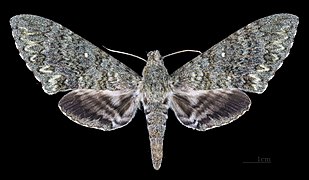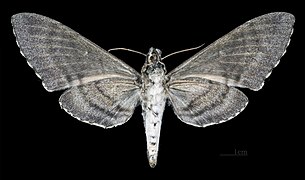Manduca muscosa
| Manduca muscosa | ||||||||||||
|---|---|---|---|---|---|---|---|---|---|---|---|---|

Manduca muscosa ♂ (preparation) |
||||||||||||
| Systematics | ||||||||||||
|
||||||||||||
| Scientific name | ||||||||||||
| Manduca muscosa | ||||||||||||
| ( Rothschild & Jordan , 1903) |
Manduca muscosa is a butterfly ( moth ) from the family of moth (Sphingidae).
features
The moths have a fore wing length of 45 to 62 millimeters, with the females being usually larger. The moths have a monochrome greenish gray fore wings with little pattern. A noticeable white discal spot is formed. With these characteristics, the species is unmistakable in North America. The moths are not very variable. Only the basic color can vary from light gray to dark gray. The hind wings have black bands and a black spot on the base.
The caterpillars are conspicuously pale green in color in all stages. At the thorax , the back is widened in a humped manner, her anal horn is long and strong. The body is covered with short, white secondary bristles, which makes the body surface appear granular. It thus resembles the surface of the leaves of food plants. The caterpillars have seven diagonal white stripes on each side of the body, which are bordered darker green towards the back.
The pupa is dark red-brown and has a smooth body surface. The short proboscis sheath is exposed. The relatively short Kremaster is wide and ends in a double point.
Occurrence
In the north of its range, in the United States, the species is only known from southeastern Arizona, but it is believed that it also occurs in southwestern New Mexico. In the south, the species is distributed across Mexico to at least Costa Rica in Central America.
Manduca muscosa inhabits canyons and alluvial lands in Arizona in the mountainous regions of the southeast, where the summer rains favor the growth of sunflower family (Asteraceae).
Way of life
The moths hatch in the evening and become active that same night. You are strongly attracted to light sources.
Flight and caterpillar times
The animals fly in one generation in the United States from June to early September. In Costa Rica you can see them from May to November.
Food of the caterpillars
The caterpillars feed on in the United States exclusively by composite flowers (Asteraceae) such as from sunflower ( Helianthus annuus ), Helianthus petiolaris or Viguiera cordifolia . What these three composites have in common is that they have very fibrous and rough leaves. Otherwise caterpillars are Verbesina gigantea , Lasianthaea fruticosa , Viguiera dentata and Eupatorium albicaule , but also Lantana camara from the family of the iron herb plants has been proven (Verbenaceae). However, they presumably also feed on the nightshade family (Solanaceae) and have been identified on trumpet trees (Bignoniaceae), such as Jacaranda caroba .
development
The females lay their eggs individually on the top and bottom of the leaves of the host plants. There are years when very many or very few eggs are laid. A large number of eggs are parasitized, causing up to 95% of the population to fail. The young caterpillars rest on the midrib on the underside of leaves. Contrary to what some authors claim, the older caterpillars are not only active at night, but also eat during the day. This constant feeding is probably due to the limited food resources, as the plants develop rapidly and their food quality decreases, but are also often eaten by other insects. In captivity, the caterpillars pupate a few centimeters deep in a chamber in the ground.
supporting documents
Individual evidence
- ↑ a b c d e f g h i James P. Tuttle: The Hawkmoths of North America, A Natural History Study of the Sphingidae of the United States and Canada. The Wedge Entomological Research Foundation, Washington, DC 2007, ISBN 978-0-9796633-0-7 .
- ↑ a b c Sphingidae of the Americas. Bill Oehlke, accessed December 17, 2011 .
literature
- James P. Tuttle: The Hawkmoths of North America, A Natural History Study of the Sphingidae of the United States and Canada. The Wedge Entomological Research Foundation, Washington, DC 2007, ISBN 978-0-9796633-0-7 .


